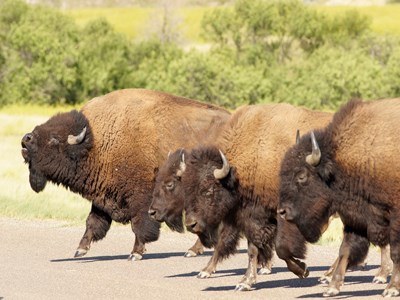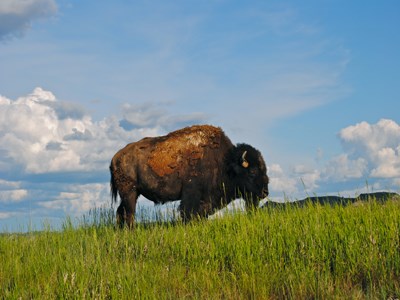Last updated: November 6, 2017
Article
Bison Bellows: Theodore Roosevelt National Park

Photo courtesy of Jeff Zylland
There are more National Park Service units devoted to Theodore Roosevelt than any other American person. Named after the 26th president of the United States, Theodore Roosevelt National Park located in North Dakota is one of these places. President Roosevelt was a champion of conservation, creating five national parks and establishing the American Bison Society to preserve wild bison. Today, Theodore Roosevelt National Park is home to two separate bison herds located in the northern and southern units of the park.
Theodore Roosevelt National Park is currently working on a unique project that intertwines visitors, bison, genetics, archaeology, and education all in one package. The project will directly benefit visitor experiences and learning opportunities as well as improve management options that can better preserve the species. This project will help researchers to better understand bison genetic diversity that existed before the herds were nearly wiped out.

Photo courtesy of Laura Thomas
Researchers at Theodore Roosevelt National Park are working with Knife River Indian Villages National Historic Site, the Midwest Archeological Center, the University of North Dakota, and the State Historical Society of North Dakota to create a genetic baseline that extends centuries into the past that will lead to the development of historical phylogenies of bison. A phylogeny is the evolutionary history of an organism and is commonly represented in a phylogenetic tree. These trees have branches that show how species evolved and developed into new species over millions of years. One way Theodore Roosevelt National Park is gathering this genetic information is by utilizing archeological collections that contain bison teeth from hundreds of years ago. Archeological collections can provide a unique perspective on the past because the bison teeth can be precisely located in time and space. Once bison teeth are selected for sampling, researchers can then extract DNA from the teeth. With the genetic data, the park will be able to learn about both the historical and current bison herds located at the park.
With the collected genetic data, Theodore Roosevelt National Park biologists can then provide information to the 500,000 visitors that visit the park annually. "This project combines the value of archeology, vertebrate collections, and interpretation," said Blake McCann, Resource Manager at Theodore Roosevelt National Park. With this information, visitors can experience and learn about the two bison herds from a biological, archaeological, and cultural perspective. The park will also create learning opportunities through podcasts, interpretive programs, and classroom presentations. This project ultimately provides opportunities for visitors to connect to the story of the American bison, discover the importance of bison to the American Indians on the Great Plains, learn about the difficulties of bison management and conservation, and gain an appreciation of an iconic species.
